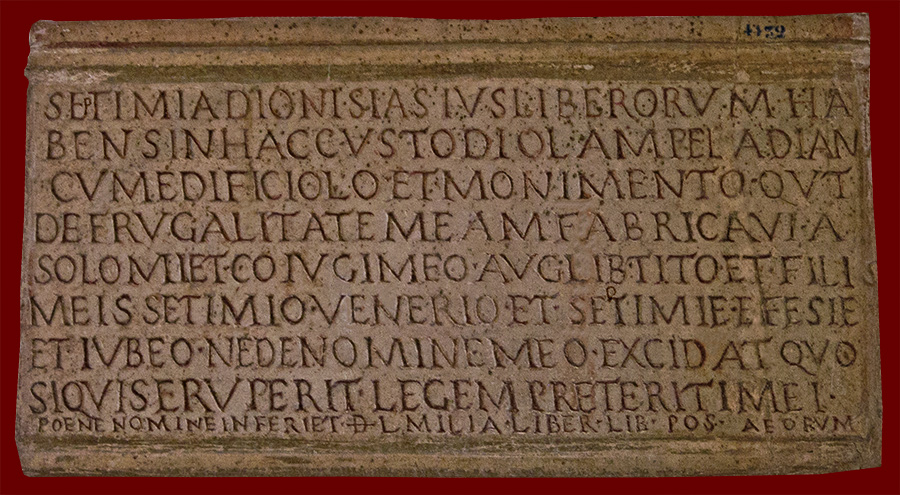
Marble tablet for Septimia Dionisias, Rome, 3rd century CE (CIL 6.10246)
Septimia Dionisias, a freedwoman known only from her own words inscribed on this marble tablet, financed and built the tomb to which it must have been affixed for herself and her family. While mistakes of grammar and inconsistencies of spelling suggest that her education was basic, the scale of the tomb, the size of her familia, and her confident and forceful self-expression reveal a wife and mother of private and public accomplishment who was keenly aware of her social status and civic rights. Her nomen indicates that she was freed by a member of the eminent gens Septimia, which produced three emperors between 193-211 CE; as was typical upon manumission, she retained her slave name as her cognomen. Having no parents to lay claim to, Dionisias proudly identified herself instead as a woman in possession of the ius liberorum, a right conferred on Roman matronae by the Augustan marriage law of 9 CE, the Lex Papia Poppaea, granting freedom from guardianship (tutela mulierum) to married freedwomen who had borne at least four children. Here she mentions only two, Septimius Venerius and Septimia Efesia, perhaps the only ones still surviving. Since they bear her nomen, they were freeborn but probably born before Septimia entered into a legitimate Roman marriage. That she did so, and with a man of the status of an imperial freedman, she makes clear with the words coniugi meo. Since the tomb has been lost it is impossible to say what it looked like, but it must have been substantial, consisting of a small structure, the aedificiolum, and a monumentum, which may refer to the commemorative inscription. Dionisias threatens a sizable fine for anyone transgressing her ownership rights or desecrating the tomb (violatio sepulcri), the latter an apparently well-grounded fear, given the number of Roman imperial laws enacted to protect burial monuments. Found in Rome, the inscription is now in the Palazzo Nuovo, one of the Capitoline Museums there, and dates most likely to the third century. Its formal errors, which may be attributed to the engraver or colloquial pronunciation, have been corrected in the text below by placing curly brackets ({ }) around superfluous letters and square brackets ([ ]) around modern additions or resolutions of abbreviations. Punctuation has been added to facilitate translation.
SEpTIMIA DIONISIAS IVS LIBERORVM HA-
BENS IN HAC CVSTODIOLA{M} PELADIAN[a]
CVM [a]EDIFICIOLO ET MONIMENTO, QV[o]T
DE FRVGALITATE MEA{M} FABRICAVI A
5 SOLO MI[hi] ET CO[n]IVGI MEO AVG[usti] LIB[erto] TITO ET FILI[i]s
MEIS, SE[p]TIMIO VENERIO ET SEpTIMI[a]E EFESIE,
ET IVBEO NE DE NOMINE MEO EXCIDAT. QVO[t]
SI QVIS {E}RVPERIT LEGEM PR[a]ETERITI MEI,
POEN[a]E NOMINE INFER{I}ET Ɖ[enarium] L MILIA.
LIBER[tis], LIB[ertabus] POSterisque] {A}EORVM
Click on the underlined words for translation aids and commentary, which will appear in a small window.